2016美国总统大选英文热点词汇
- 格式:docx
- 大小:28.44 KB
- 文档页数:14
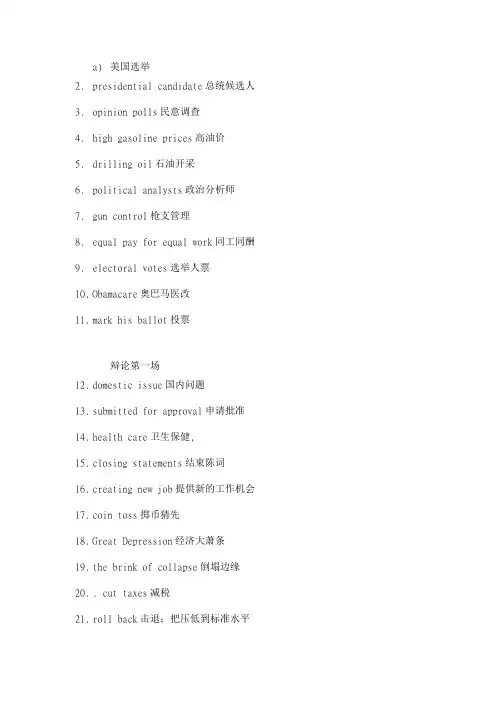
a)美国选举2.presidential candidate总统候选人3.opinion polls民意调查4.high gasoline prices高油价5.drilling oil石油开采6.political analysts政治分析师7.gun control枪支管理8.equal pay for equal work同工同酬9.electoral votes选举人票10.Obamacare奥巴马医改11.mark his ballot投票辩论第一场12.domestic issue国内问题13.submitted for approval申请批准14.health care卫生保健,15.closing statements结束陈词16.creating new job提供新的工作机会17.coin toss掷币猜先18.Great Depression经济大萧条19.the brink of collapse倒塌边缘20.. cut taxes减税21.roll back击退;把压低到标准水平22.invest in education教育投资23.wind down平静下来24.deficit赤字25.economic patriotism经济爱国主义26.crack down on 制裁27.balanced budget平衡预算28.trickle-down government垂滴式投资29.corporate tax rate公司税率30.extraordinary recession超常衰退31.loophole漏洞32.middle-income families中等收入家庭33.payroll tax工资税,34.property tax不动产税35.sales pitch推销商品的言辞36.tax breaks税收减免37.surplus剩余的38.Economic growth this year slower than last year, and last year slower thanthe year before39.tackle the deficit problem处理赤字问题40.massive economic crisis巨大的经融危机.41.deficit-reduction plan赤字消减计划.42.nomination提名,43.recession衰退44.revenue-neutral不会谋取额外收益45.autistic自闭的;孤僻的46.the federal government联邦政府47.Social Security社会保障48.prescription drug处方药49.under that scenario在这种情况下50.in fairness公正地51.decent相当好的52.primary beneficiary首要受益人53.private sector私营部门54.premium保险费,附加费55.administrative cost管理费用56.excessive过分的、过多的.57.boon恩惠福利58.leverage手段、影响力59.mortgage抵押60.churn out艰苦做出61.capital requirements资本的必要条件62.taxpayer bailouts纳税人救助63.repeal废除64.designate指定的65.blank check空头支票66.Congressional Budget Office国会预算局67.additional premium追加保费、附加保险费.68.arbitrary武断专制的69.lifetime limit终生最高赔偿限额70.irony讽刺71.identical完全相同的72.senator参议员73.partisan党派的74.fend 照料75.pay premiums付保险费76.institutionalize制度化77.get a rebate获得折扣.78.pre-existing condition已存在的医疗状况79.run for office竞选80.incentive动机81.vibrant economy充满生机的经济.82.create frameworks创建框架nd grant colleges政府赠地学院,yoff裁员85.the Constitution宪法the Declaration of Independence独立宣言.86.endow赋予87.Creator 造物主88.the pursuit of happiness当幸福来敲门89.pursue their dream追逐梦想90.food stamps粮票91.primary responsibility首要责任92.have commitment to恪守承诺93.legislative functions立法功能94.in a state of paralysis处于瘫痪状态95.partisan gridlock党派僵局96.undiminished未衰退的辩论第三场97.Democrats 民主党98.Republicans.共和党ernor州长100.foreign policy外交政策101.installed nuclear missiles102.national security 国防安全103.the challenge of a changing Middle East and the new face of terrorism 中东的新变化和恐怖主义新形势104.controversy争议105.ambassador大使106.spontaneous自然而然发生的107.an intelligence failure情报错误108. a pretty dramatic reversal in the kind of hopes事与愿违prehensive and robust strategy全面坚定的计划110.radical violent extremism激进极端的暴力,极端恐怖主义111.an enormous threat巨大的威胁112.extremism极端主义mander in chief军队总指挥114.refocused our attention on将关注点重新放在。
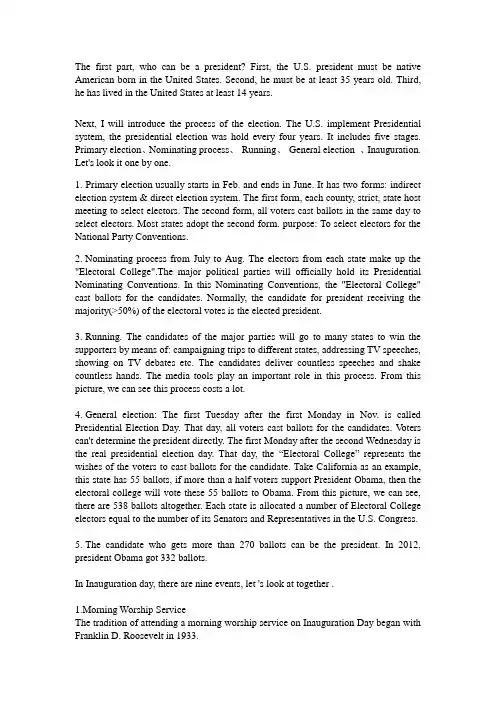
The first part, who can be a president? First, the U.S. president must be native American born in the United States. Second, he must be at least 35 years old. Third, he has lived in the United States at least 14 years.Next, I will introduce the process of the election. The U.S. implement Presidential system, the presidential election was hold every four years. It includes five stages. Primary election、Nominating process、Running、General election 、Inauguration. Let's look it one by one.1. Primary election usually starts in Feb. and ends in June. It has two forms: indirect election system & direct election system. The first form, each county, strict, state host meeting to select electors. The second form, all voters cast ballots in the same day to select electors. Most states adopt the second form. purpose: To select electors for the National Party Conventions.2.Nominating process from July to Aug. The electors from each state make up the "Electoral College".The major political parties will officially hold its Presidential Nominating Conventions. In this Nominating Conventions, the "Electoral College" cast ballots for the candidates. Normally, the candidate for president receiving the majority(>50%) of the electoral votes is the elected president.3.Running. The candidates of the major parties will go to many states to win the supporters by means of: campaigning trips to different states, addressing TV speeches, showing on TV debates etc. The candidates deliver countless speeches and shake countless hands. The media tools play an important role in this process. From this picture, we can see this process costs a lot.4.General election: The first Tuesday after the first Monday in Nov. is called Presidential Election Day. That day, all voters cast ballots for the candidates. V oters can't determine the president directly. The first Monday after the second Wednesday is the real presidential election day. That day, the “Electoral College”represents the wishes of the voters to cast ballots for the candidate. Take California as an example, this state has 55 ballots, if more than a half voters support President Obama, then the electoral college will vote these 55 ballots to Obama. From this picture, we can see, there are 538 ballots altogether. Each state is allocated a number of Electoral College electors equal to the number of its Senators and Representatives in the U.S. Congress.5.The candidate who gets more than 270 ballots can be the president. In 2012, president Obama got 332 ballots.In Inauguration day, there are nine events, let 's look at together .1.Morning Worship ServiceThe tradition of attending a morning worship service on Inauguration Day began with Franklin D. Roosevelt in 1933.2.Procession to the CapitolBy tradition, the outgoing President accompanies the President-elect to the Capitol for the swearing-in ceremony.3.Vice President’s Swearing-In CeremonyUntil 1937, the Vice President was sworn into office in the Senate.4.President’s Swearing-In Ceremony5.Inaugural AddressSince George Washington in 1789, every President has delivered an Inaugural address.6.Departure of the Outgoing PresidentFollowing the inaugural ceremony on the west front of the U.S. Capitol, the outgoing President and First Lady leave the Capitol to begin their post-presidential lives.7.Inaugural LuncheonSince 1953, a luncheon was hosted at the U.S. Capitol for the new President, Vice President, and guests.8.Inaugural ParadeWhile early parades were mostly military escorts, by 1841, floats, citizens groups, and bands became standard.9.Inaugural BallThe first Inaugural ball in Washington was thrown for James and Dolley Madison in 1809.The final part is presidential oath. Firstly, I will introduce some details about the oath. Later, I will show you a short video about the oath of the president Obama.1.Presidents say their name after the first " I"2.Presidents raise their right hand and put their left hand on the bible while swearing in.3.The Chief Justice of the Supreme Court(最高法院首席法官) swears in the President of the United States.4.The swearing in ceremony was held in Washington, D.C.5.It is customary for presidents to add the words "So help me God " to the end of the oath .6.Presidents give an inaugural speech after their oath.。
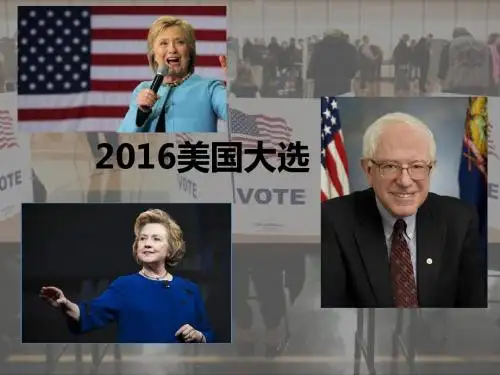
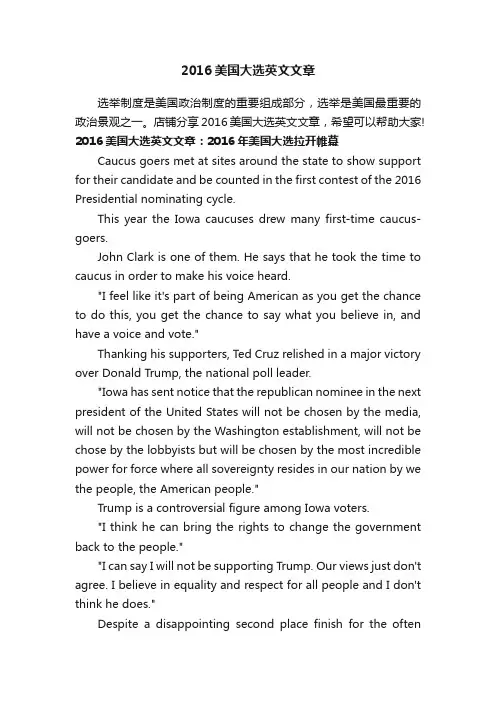
2016美国大选英文文章选举制度是美国政治制度的重要组成部分,选举是美国最重要的政治景观之一。
店铺分享2016美国大选英文文章,希望可以帮助大家! 2016美国大选英文文章:2016年美国大选拉开帷幕Caucus goers met at sites around the state to show support for their candidate and be counted in the first contest of the 2016 Presidential nominating cycle.This year the Iowa caucuses drew many first-time caucus-goers.John Clark is one of them. He says that he took the time to caucus in order to make his voice heard."I feel like it's part of being American as you get the chance to do this, you get the chance to say what you believe in, and have a voice and vote."Thanking his supporters, Ted Cruz relished in a major victory over Donald Trump, the national poll leader."Iowa has sent notice that the republican nominee in the next president of the United States will not be chosen by the media, will not be chosen by the Washington establishment, will not be chose by the lobbyists but will be chosen by the most incredible power for force where all sovereignty resides in our nation by we the people, the American people."Trump is a controversial figure among Iowa voters."I think he can bring the rights to change the government back to the people.""I can say I will not be supporting Trump. Our views just don't agree. I believe in equality and respect for all people and I don't think he does."Despite a disappointing second place finish for the oftenbombastic real-estate mogul, Trump was gracious in conceding defeat."I am really honored. And I want to congratulate Ted and I want to congratulate all of the incredible candidates including Mike Huckabee."Analysts say that Florida Senator Marco Rubio is likely to enjoy increased momentum going forward.Rubio finished a solid third, just one percentage point behind Trump but well ahead of the rest of the GOP field.Hillary Clinton endured a nail-biter of a night that finished in a virtual tie with Bernie Sanders.Clinton says she will keep fighting on in her address to supporters."I want you to know I will keep doing what I have done my entire life. I will keep standing up for you. I will keep fighting for you. I will always work to achieve the America that I believe in where the promise of that dream that we hold out to our children and our grandchildren never fades but inspires generations to come. Join me, let's go win the nomination."Although for many, tonight is just the beginning of a long slog to the two major parties national conventions in August, it also marks the end of the line for candidates who failed to gain traction.Two contenders: Maryland Governor Martin O'Malley and former Arkansas Governor Mike Huckabee, dropped out after poor showings today in Iowa.2016美国大选英文文章:US Presidential Race Could Be Clearer This WeekIt could become clear this week who the Republican and Democratic presidential nominees will be.Twelve states will hold primary elections or caucuses Tuesday, called “Super Tuesday.” In most of those states, public opinion studies show Republican Donald Trump and Democrat Hillary Clinton have much more support than other candidates.Last week, Trump said people “are so tired of these politicians -- all talk, no action. We are going to make America great again. We are going to win, win, win.”Republican candidates said they will try to stop or at least slow Trump’s campaign.Senator Marco Rubio said “Trump will never be the Republican nominee. We are not going to let the conservative movement, and the party of Ronald Reagan and the party of Abraham Lincoln be taken over by a first-rate con artist.”Trump answered that Rubio has not won any caucuses or primary elections. He said Rubio is hated in his home state of Florida.Clinton has also criticized Trump. After she defeated Senator Bernie Sanders in the South Carolina primary Saturday by almost 50 points, she said, “we do not need to make America great again. America has never stopped being great. But we do need to make America whole again. Instead of building walls, we need to be tearing down barriers.”Senator Sanders says his campaign against Hillary Clinton is not over. He said “the middle class of this country has been shrinking and almost all new income and wealth has been going to the top one percent.”2016美国大选英文文章:美2016总统大选拉开帷幕奥巴马死对头宣布参选In the U.S., the 2016 presidential campaign season is on. It kicked off yesterday with anannouncement from Senator TedCruz, a Republican candidate from Texas who said he wasrunning for president.The election won't be until next November 8. But announcing they're running helps candidatesramp up their fundraising, shape their messages and campaign strategies and reach out tovoters.In the 2016 election, there's no incumbent president. President Obama has reached to twoterm limit set by the Twenty-Second Amendment to "The Constitution." It was ratified in 1951.So what this means is that the field for 2016 is wide open for both Republicans and Democratswho want to move to the White House.The Thirteenth Amendment to the U.S. "Constitution" abolished slavery in the U.S. in 1865. TheUnited Nations Universal Declaration of Human Rights abolished slavery worldwide in 1948.And yet, there are more slaves on earth today than at any point in human history.A few years ago, CNN launched The Freedom Project. Its goals include showing the horrors ofmodern-day slavery, exposing the criminals who trade in human lives, amplifying the voices ofthe slaves themselves and highlighting the success stories of those working to abolish slavery.Between 20 million and 36 million that's the estimated number of people enslaved worldwideright now. Modern-day slavery can be found on every continent.The stories of the survivors are painful, shocking and sometimes hard to hear.On this farm, we find Abdul. He survived three years of work. He's just 10. He earns no wagesfor his work, he says.Gerva Waiti is the mother of three. Her eldest daughtershould not be this skilled at brickmaking. She is only five years old.。
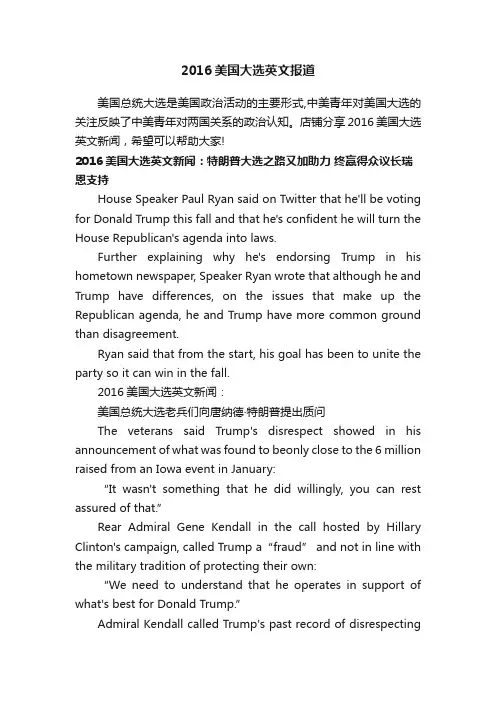
2016美国大选英文报道美国总统大选是美国政治活动的主要形式,中美青年对美国大选的关注反映了中美青年对两国关系的政治认知。
店铺分享2016美国大选英文新闻,希望可以帮助大家!2016美国大选英文新闻:特朗普大选之路又加助力终赢得众议长瑞恩支持House Speaker Paul Ryan said on Twitter that he'll be voting for Donald Trump this fall and that he's confident he will turn the House Republican's agenda into laws.Further explaining why he's endorsing Trump in his hometown newspaper, Speaker Ryan wrote that although he and Trump have differences, on the issues that make up the Republican agenda, he and Trump have more common ground than disagreement.Ryan said that from the start, his goal has been to unite the party so it can win in the fall.2016美国大选英文新闻:美国总统大选老兵们向唐纳德·特朗普提出质问The veterans said Trump's disrespect showed in his announcement of what was found to beonly close to the 6 million raised from an Iowa event in January:“It wasn't something that he did willingly, you can rest assured of that.”Rear Admiral Gene Kendall in the call hosted by Hillary Clinto n's campaign, called Trump a“fraud” and not in line with the military tradition of protecting their own:“We need to understand that he operates in support of what's best for Donald Trump.”Admiral Kendall called Trump's past record of disrespectingvetera ns “flagrant”.2016美国大选英文新闻:美国2016年总统大选谁是幕后捐款者?US federal election law requires all candidates to report each campaign donation to theFederal Election Committee (FEC). These filings offer insight into who is willing to put theirmoney where their vote is.美国联邦选举法规定,所有候选人必须向联邦选举委员会报告每个选举阵营所收到的捐款。
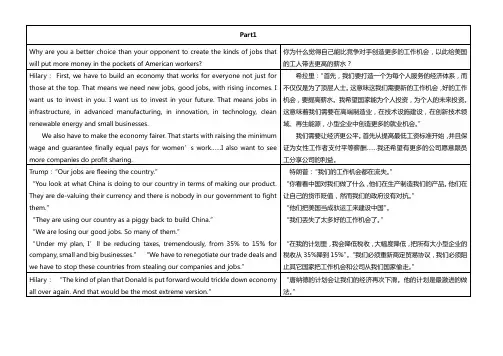
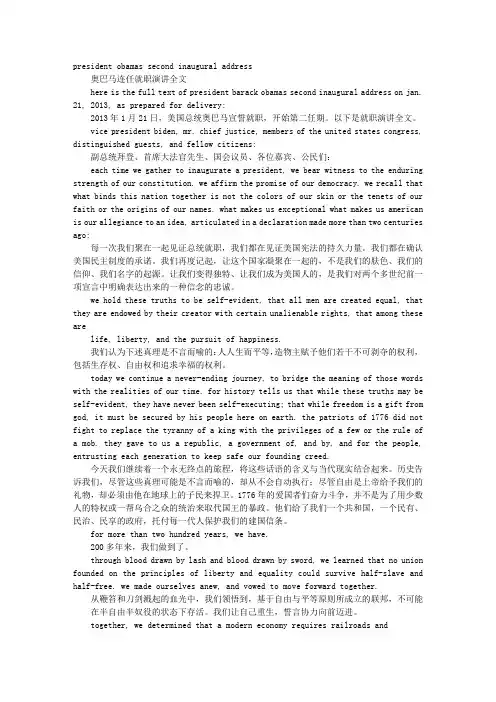
president obamas second inaugural address 奥巴马连任就职演讲全文here is the full text of president barack obamas second inaugural address on jan.21, 2013, as prepared for delivery: 2013年1月21日,美国总统奥巴马宣誓就职,开始第二任期。
以下是就职演讲全文。
vice president biden, mr. chief justice, members of the united states congress,distinguished guests, and fellow citizens: 副总统拜登、首席大法官先生、国会议员、各位嘉宾、公民们:each time we gather to inaugurate a president, we bear witness to the enduringstrength of our constitution. we affirm the promise of our democracy. we recall thatwhat binds this nation together is not the colors of our skin or the tenets of ourfaith or the origins of our names. what makes us exceptional what makes us americanis our allegiance to an idea, articulated in a declaration made more than two centuriesago:每一次我们聚在一起见证总统就职,我们都在见证美国宪法的持久力量。
我们都在确认美国民主制度的承诺。
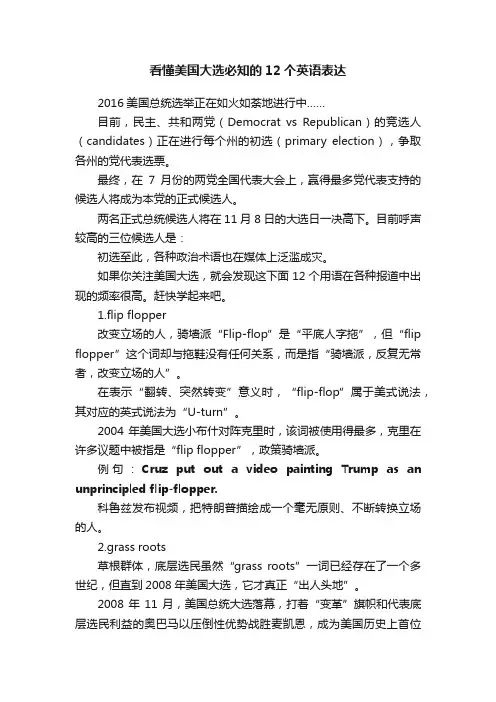
看懂美国大选必知的12个英语表达2016美国总统选举正在如火如荼地进行中……目前,民主、共和两党(Democrat vs Republican)的竞选人(candidates)正在进行每个州的初选(primary election),争取各州的党代表选票。
最终,在7月份的两党全国代表大会上,赢得最多党代表支持的候选人将成为本党的正式候选人。
两名正式总统候选人将在11月8日的大选日一决高下。
目前呼声较高的三位候选人是:初选至此,各种政治术语也在媒体上泛滥成灾。
如果你关注美国大选,就会发现这下面12个用语在各种报道中出现的频率很高。
赶快学起来吧。
1.flip flopper改变立场的人,骑墙派“Flip-flop”是“平底人字拖”,但“flip flopper”这个词却与拖鞋没有任何关系,而是指“骑墙派,反复无常者,改变立场的人”。
在表示“翻转、突然转变”意义时,“flip-flop”属于美式说法,其对应的英式说法为“U-turn”。
2004年美国大选小布什对阵克里时,该词被使用得最多,克里在许多议题中被指是“flip flopper”,政策骑墙派。
例句:Cruz put out a video painting Trump as an unprincipled flip-flopper.科鲁兹发布视频,把特朗普描绘成一个毫无原则、不断转换立场的人。
2.grass roots草根群体,底层选民虽然“grass roots”一词已经存在了一个多世纪,但直到2008年美国大选,它才真正“出人头地”。
2008年11月,美国总统大选落幕,打着“变革”旗帜和代表底层选民利益的奥巴马以压倒性优势战胜麦凯恩,成为美国历史上首位黑人总统。
这里的“底层民众”除了用“the ordinary people”表达,还可以用“the grass roots”指代。
例句:The feeling among the grass roots of the Party is that the leaders are not radical enough.广大基层党员认为他们的领导行事不够彻底。
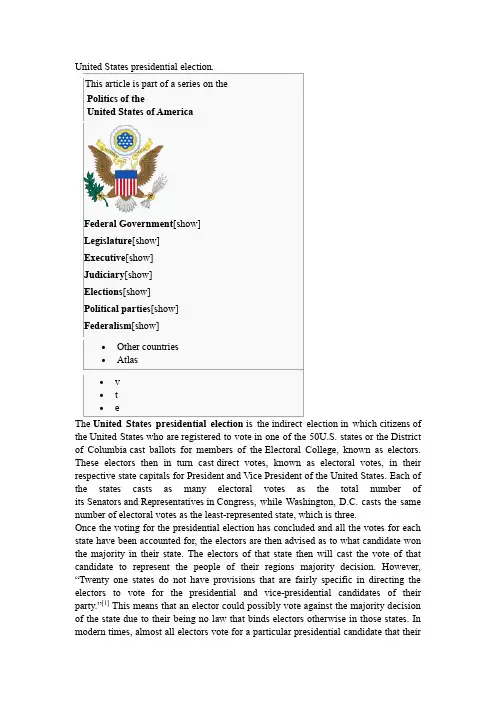
election in which citizens of the United States who are registered to vote in one of the 50U.S. states or the District of Columbia cast ballots for members of the Electoral College, known as electors. These electors then in turn cast direct votes, known as electoral votes, in their respective state capitals for President and Vice President of the United States. Each of the states casts as many electoral votes as the total number of its Senators and Representatives in Congress, while Washington, D.C. casts the same number of electoral votes as the least-represented state, which is three.Once the voting for the presidential election has concluded and all the votes for each state have been accounted for, the electors are then advised as to what candidate won the majority in their state. The electors of that state then will cast the vote of that candidate to represent the people of their regions majority decision. However, “Twenty one states do not have provisions that are fairl y specific in directing the electors to vote for the presidential and vice-presidential candidates of their party.”[1] This means that an elector could possibly vote against the majority decision of the state due to their being no law that binds electors otherwise in those states. In modern times, almost all electors vote for a particular presidential candidate that theirstates majority decided upon; thus, the results of the election can generally be determined based on the state-by-state popular vote. The candidate who receives an absolute majority of electoral votes for President or Vice President (currently, at least 270 out of a total of 538) is then projected to be elected to that office. If no candidate receives an absolute majority of electoral votes for President, the House of Representatives chooses the President; if no candidate receives an absolute majority for Vice President, the Senate chooses the Vice President.These presidential elections occur quadrennially. Registered voters cast their ballots on Election Day, which since 1845 has been the Tuesday after the first Monday in November (i.e.,the first Tuesday after November 1),[2][3][4] coinciding with the general elections of various other federal, state, and local races. The Electoral College electors then schedule to formally cast their electoral votes on the first Monday after the second Wednesday of December (i.e., the first Monday after December 12) at their respective state capitals. Congress then certify the results in early January, and the presidential term begins on Inauguration Day, which since the passage of the Twentieth Amendment has been set at January 20.The Electoral College and its procedure is established in the U.S. Constitution by Article II, Section 1, Clauses 2 and 4; and the Twelfth Amendment(which replaced Clause 3 after it was ratified in 1804). Under Article II, Section 1, Clause 2, the manner for choosing electors is determined by each state legislature, not directly by the federal government. Many state legislatures used to select their electors directly instead of using any form of popular vote, but the political parties in the various states now conduct their own separate elections to help choose their slate of electors. The Twenty-third Amendment, ratified in 1961, then granted electoral votes to Washington, D.C. Electors can vote for anyone, butunpledged electors or faithless electors have been rare in modern times.The nomination process, consisting of the primary elections and caucuses and the nominating conventions, was not specified in the Constitution, but was developed over time by the states and thepolitical parties. These primary elections are generally held between January and June before the general election in November, while the nominating conventions are held in the summer. This too is an indirect election process, one in which voters in the various states, the District of Columbia, as well as those in U.S. territories, cast ballots for a slate of delegates to a political party's nominating convention, who then in turn elect their party's presidential nominee. Each party's presidential nominee or the convention may then choose a vice presidential running mate to join with him or her on the same ticket, and this choice is often rubber-stamped by the conventions, depending on that convention's rules. Because of changes to national campaign finance laws since the 1970s regarding the disclosure of contributions for federal campaigns, presidential candidates from the major political parties usually declare their intentions to run as early as the spring of the previous calendar year before the election (almost 18 months before Inauguration Day).[5]A 2016 general election ballot, listing the presidential and vice presidential candidates Contents[hide]∙1History∙2Procedureo 2.1Eligibility requirementso 2.2Nominating processo 2.3The popular vote on Election Dayo 2.4Electoral collegeo 2.5Election calendar∙3Trendso 3.1Previous experienceo 3.2Technology and media∙4Criticismso 4.1Proposed changes to the election process∙5Electoral college results∙6V oter turnout∙7Financial disclosures∙8Presidential coattailso8.1Comparison with other U.S. general elections∙9See also∙10Notes∙11External linksHistory[edit]Article Two of the United States Constitution originally established the method of presidential elections, including the Electoral College. This was a result of a compromise between those constitutional framers who wanted the Congress to choose the president, and those who preferred a national popular vote.[6]Each state is allocated a number of electors that is equal to the size of its delegation in both houses of Congress combined. With the ratification of the 23rd Amendment to the Constitution in 1961, the District of Columbia is also granted a number of electors, equal to the number of those held by the least populous state. However, U.S. territories are not represented in the Electoral College.Constitutionally, the manner for choosing electors is determined within each state by its legislature. During the first presidential election in 1789, only 6 of the 13 original states chose electors by any form of popular vote.[7] Gradually throughout the years, the states began conducting popular elections to help choose their slate of electors, resulting in the overall, nationwide indirect election system that it is today.Under the original system established by Article Two, electors could cast two votes to two different candidates for president. The candidate with the highest number of votes (provided it was a majority of the electoral votes) became the president, and the second-place candidate became the vice president. This presented a problem during the presidential election of 1800 when Aaron Burrreceived the same number of electoral votes as Thomas Jefferson and challenged Jefferson's election to the office. In the end, Jefferson was chosen as the president because of Alexander Hamilton's influence in the House of Representatives. This added to the deep rivalry between Burr and Hamilton which resulted in their famous 1804 duel.In response to the 1800 election, the 12th Amendment was passed, requiring electors to cast two distinct votes: one for President and another for Vice President. While this solved the problem at hand, it ultimately had the effect of lowering the prestige of the Vice Presidency, as the office was no longer for the leading challenger for the Presidency. The separate ballots for President and Vice President became something of a moot issue later in the 19th century when it became the norm for popular elections to determine a state's Electoral College delegation. Electors chosen this way are pledged to vote for a particular presidential and vice presidential candidate (offered by the same political party). So, while the Constitution says that the President and Vice President are chosen separately, in practice they are chosen together.The 12th Amendment also established rules when no candidate wins a majority vote in the Electoral College. In the presidential election of 1824, Andrew Jackson received a plurality, but not a majority, of electoral votes cast. The election was thrown to the House of Representatives, and John Quincy Adams was elected to the presidency. A deep rivalry resulted between Andrew Jackson and House Speaker Henry Clay, who had also been a candidate in the election.Since 1824, aside from the occasional "faithless elector," the popular vote determines the winner of a presidential election by determining the electoral vote, as each state or district's popular vote determines its electoral college vote. Although the nationwide popular vote does not directly determine the winner of a presidential election, it does strongly correlate with who is the victor. In 52 of the 56 total elections held so far (about 93 percent), the winner of the national popular vote has also carried the Electoral College vote. The winners of the nationwide popular vote and the Electoral College vote differ only in close elections. In highly competitive elections, candidates focus on turning out their vote in the contested swing states critical to winning an electoral college majority, so they do not try to maximize their popular vote by real or fraudulent vote increases in one-party areas.[8]However, candidates can fail to get the most votes in the nationwide popular vote in a Presidential election and still win that election. In the 1824 election, Jackson won the popular vote, but no one received the majority of electoral votes. According to the12th Amendment in the Constitution, the House of Representatives must choose the president out of the top 3 people in the election. Clay had come fourth, so he threw his support to Adams, who then won. Because Adams later named Clay his Secretary of State, Jackson's supporters claimed that Adams gained the presidency by making a deal with Clay. Charges of a "corrupt bargain" followed Adams through his term.Comparison of the popular vote totals since 1900.RepublicanDemocratAll other candidates togetherThen in 1876, 1888, 2000, and 2016, the winner of electoral vote lost the popular vote outright. Numerous constitutional amendments have been submitted seeking to replace the Electoral College with a direct popular vote, but none has ever successfully passed both Houses of Congress. Another alternate proposal is the National Popular V ote Interstate Compact, an interstate compact whereby individual participating states agree to allocate their electors based on the winner of the national popular vote instead of just their respective statewide results.The presidential election day was established on a Tuesday in the month of November because of the factors involved (weather, harvests and worship). When voters used to travel to the polls by horse, Tuesday was an ideal day because it allowed people to worship on Sunday, ride to their county seat on Monday, and vote on Tuesday–all before market day, Wednesday. The month of November also fits nicely between harvest time and harsh winter weather, which could be especially bad to people traveling by horse and buggy.[9]Until 1937, presidents were not sworn in until March 4 because it took so long to count and report ballots, and because of the winner's logistical issues of moving to the capital. With better technology and the 20th Amendment being passed, presidential inaugurations were moved to noon on January 20–allowing presidents to start their duties sooner.[9]The Federal Election Campaign Act of 1971 was enacted to increase disclosure of contributions for federal campaigns. Subsequent amendments to law require that candidates to a federal office must file a Statement of Candidacy with the Federal Election Commission before they can receive contributions aggregating in excess of $5,000 or make expenditures aggregating in excess of $5,000. Thus, this began a trend of presidential candidates declaring their intentions to run as early as the Spring of the previous calendar year so they can start raising and spending the money needed for their nationwide campaign.[5]The first president, George Washington, was elected as an independent. Since the election of his successor, John Adams, in 1796, all winners of U.S. presidential elections have represented one of two major parties. Third parties have taken secondplace only twice, in 1860 and 1912. The last time a third (independent) candidate achieved significant success (although still finishing in third place) was in 1992, and the last time a third-party candidate received any electoral votes not from faithless electors was in 1968.Procedure[edit]Eligibility requirements[edit]The hand-written copy of the natural-born-citizen clause as it appeared in 1787 Article Two of the United States Constitution stipulates that for a person to serve as President, the individual must be a natural-born citizen of the United States, at least35 years old, and a resident of the United States for a period of no less than 14 years.A candidate may start running his or her campaign early before turning 35 years old or completing 14 years of residency, but must meet the age and residency requirements byInauguration Day. The Twenty-second Amendment to the Constitution also sets a term limit: a President cannot be elected to more than two terms.The U.S. Constitution also has two provisions that apply to all federal offices in general, not just the presidency. Article I, Section 3, Clause 7 states that if the U.S. Congress convicts any officer on impeachment, they may also bar that person from holding any public office in the future. And Section 3 of the Fourteenth Amendment prohibits the election to any federal office of any person who had held any federal or state office and then engaged in insurrection, rebellion or treason; this disqualification can be waived if such an individual gains the consent of two-thirds of both houses of Congress.In addition, the Twelfth Amendment establishes that the Vice-President must meet all of the qualifications of being a President.Although not a mandatory requirement, Federal campaign finance laws including the Federal Election Campaign Act state that a candidate who intends to receive contributions aggregating in excess of $5,000 or make expenditures aggregating in excess of $5,000, among others, must first file a Statement of Candidacy with the Federal Election Commission.[10] This has led presidential candidates, especially members from the two major political parties, to officially announce their intentions to run as early as the spring of the previous calendar year so they can start raising or spending the money needed for their nationwide campaign.[5] Potential candidates usually form exploratory committees even earlier to determining the feasibility of them actually running.Nominating process[edit]Main articles: United States presidential primary and United States presidential nominating conventionA 2008 Democratic caucus meeting in Iowa City, Iowa. The Iowa caucuses are traditionally the first major electoral event of presidential primaries and caucuses.Madison Square Garden in New York City, the site of the 1976, 1980, and 1992 Democratic National Conventions; and the 2004 Republican National Convention.The floor of the 2008 Republican National Convention at the Xcel Energy Center in Saint Paul, Minnesota.The modern nominating process of U.S. presidential elections consists of two major parts: a series of presidential primary elections and caucuses held in each state, and the presidential nominating conventions held by each political party. This process was never included in the United States Constitution, and thus evolved over time by the political parties to clear the field of candidates.The primary elections are run by state and local governments, while the caucuses are organized directly by the political parties. Some states hold only primary elections, some hold only caucuses, and others use a combination of both. These primaries and caucuses are staggered generally between January and June before the federal election, with Iowa and New Hampshire traditionally holding the first presidential state caucus and primary, respectively.Like the general election, presidential caucuses or primaries are indirect elections. The major political parties officially vote for their presidential candidate at their respective nominating conventions, usually all held in the summer before the federal election. Depending on each state's law and state's political party rules, when voters cast ballots for a candidate in a presidential caucus or primary, they may be voting to awarddelegates "bound" to vote for a candidate at the presidential nominating conventions, or they may simply be expressing an opinion that the state party is not bound to follow in selecting delegates to their respective national convention.Unlike the general election, voters in the U.S. territories can also elect delegates to the national conventions. Furthermore, each political party can determine how many delegates to allocate to each state and territory. In 2012 for example, the Democratic and Republican party conventions each used two different formulas to allocate delegates. The Democrats-based theirs on two main factors: the proportion of votes each state gave to the Democratic candidate in the previous three presidential elections, and the number of electoral votes each state had in the Electoral College.[11] In contrast, the Republicans assigned to each state 10 delegates, plus 3 delegates per congressional district.[12] Both parties then gave fixed amounts of delegates to each territory, and finally bonus delegates to states and territories that passed certain criteria.[11][12]Along with delegates chosen during primaries and caucuses, state and U.S. territory delegations to both the Democratic and Republican party conventions also include "unpledged" delegates that have a vote. For Republicans, they consist of the three top party officials from each state and territory. Democrats have a more expansive group of unpledged delegates called "superdelegates", who are party leaders and elected officials.Each party's presidential candidate also chooses a vice presidential nominee to run with him or her on the same ticket, and this choice is rubber-stamped by the convention.If no single candidate has secured a majority of delegates (including both pledged and unpledged), then a "brokered convention" results. All pledged delegates are then "released" and are able to switch their allegiance to a different candidate. Thereafter, the nomination is decided through a process of alternating political horse trading, and additional rounds of re-votes.[13][14][15][16]The conventions have historically been held inside convention centers, but since the late 20th century both the Democratic and Republican parties have favoredsports arenas and domed stadiums to accommodate the increasing attendance.The popular vote on Election Day[edit]A Texas voter about to mark a selection for president on a ballot, 2008 Election Day Under the United States Constitution, the manner of choosing electors for the Electoral College is determined by each state's legislature. Although each state designates electors by popular vote, other methods are allowed. For instance, insteadof having a popular vote, a number of states used to select presidential electors by a direct vote of the state legislature itself.However, federal law does specify that all electors must be selected on the same day, which is "the first Tuesday after the first Monday in November," i.e., a Tuesday no earlier than November 2 and no later than November 8.[17] Today, the states and the District of Columbia each conduct their own popular elections on Election Day to help determine their respective slate of electors. Thus, the presidential election is really an amalgamation of separate and simultaneous state elections instead of a single national election run by the federal government.Like any other election in the United States, the eligibility of an individual for voting is set out in the Constitution and regulated at state level. The Constitution states that suffrage cannot be denied on grounds of race or color, sex or age for citizens eighteen years or older. Beyond these basic qualifications, it is the responsibility of state legislatures to regulate voter eligibility.Generally, voters are required to vote on a ballot where they select the candidate of their choice. The presidential ballot is a vote "for the electors of a candidate" meaning that the voter is not voting for the candidate, but endorsing a slate of electors pledged to vote for a specific presidential and vice presidential candidate.Many voting ballots allow a voter t o “blanket vote” for all candidates in a particular political party or to select individual candidates on a line by line voting system. Which candidates appear on the voting ticket is determined through a legal process known as ballot access. Usually, the size of the candidate's political party and the results of the major nomination conventions determine who is pre-listed on the presidential ballot. Thus, the presidential election ticket will not list every candidate running for President, but only those who have secured a major party nomination or whose size of their political party warrants having been formally listed. Laws are in effect to have other candidates pre-listed on a ticket, provided that enough voters have endorsed the candidate, usually through a signature list.The final way to be elected for president is to have one's name written in at the time of election as a write-in candidate. This is used for candidates who did not fulfill the legal requirements to be pre-listed on the voting ticket. It is also used by voters to express a distaste for the listed candidates, by writing in an alternative candidate for president such as Mickey Mouse or comedian Stephen Colbert (whose application was voted down by the South Carolina Democratic Party). In any event, a write-in candidate has never won an election for President of the United States.Because U.S. territories are not represented in the Electoral College, U.S. citizens in those areas do not vote in the general election for President. Guam has held straw polls for president since the 1980 election to draw attention to this fact.[18]Electoral college[edit]Main article: Electoral College (United States)Electoral College map showing the results of the 2016 U.S. presidential election. Republican candidate Donald Trump won the popular vote in 30 states (denoted in red) to capture 305 electoral votes (plus 1 electoral vote from Maine's second congressional district). Democraticcandidate Hillary Clinton won the popular vote in 20 states and Washington, D.C. (denoted in blue) to capture 232 electoral votes.Most state laws establish a winner-take-all system, wherein the ticket that wins a plurality of votes wins all of that state's allocated electoral votes, and thus has their slate of electors chosen to vote in the Electoral College. Maine and Nebraska do not use this method, instead giving two electoral votes to the statewide winner and one electoral vote to the winner of each Congressional district.Each state's winning slate of electors then meets at their respective state's capital on the first Monday after the second Wednesday in December to cast their electoral votes on separate ballots for President and Vice President. Although Electoral College members can technically vote for anyone under the U.S. Constitution, 24 states have laws to punish faithless electors,[19] those who do not cast their electoral votes for the person whom they have pledged to elect.In early January, the total Electoral College vote count is opened by the sitting Vice President, acting in his capacity as President of the Senate, and read aloud to a joint session of the incoming Congress, which was elected at the same time as the President.If no candidate receives a majority of the electoral vote (at least 270), the President is determined by the rules outlined by the 12th Amendment. Specifically, the selection of President would then be decided by a contingent election in a ballot of the House of Representatives. For the purposes of electing the President, each state has only one vote. A ballot of the Senate is held to choose the Vice President. In this ballot, each senator has one vote. The House of Representatives has chosen the victor of the presidential race only twice, in 1800 and 1824; the Senate has chosen the victor of the vice-presidential race only once, in 1836.If the President is not chosen by Inauguration Day, the Vice President-elect acts as President. If neither are chosen by then, Congress by law determines who shall act as President, pursuant to the 20th Amendment.Unless there are faithless electors, disputes, or other controversies, the events in December and January mentioned above are largely a formality since the winner canbe determined based on the state-by-state popular vote results. Between the general election and Inauguration Day, this apparent winner is referred to as the "President-elect" (unless it is a sitting President that has won re-election).Election calendar[edit]The typical periods of the presidential election process are as follows, with the dates corresponding to the 2016 general election:∙Spring 2015 – Candidates announce their intentions to run, and (if necessary) file their Statement of Candidacy with the Federal Election Commission ∙August 2015 to March 2016 – Primary and caucus debates∙February 1 to June 14, 2016 – Primaries and caucuses∙April to August, 2016 – Nominating conventions (including those of the minor third parties)∙September and October, 2016 – Presidential election debates∙November 8, 2016 – Election Day∙December 19, 2016 – Electors cast their electoral votes∙January 6, 2017 – Congress counts and certifies the electoral votes∙January 20, 2017 – Inauguration DayTrends[edit]Previous experience[edit]See also: List of Presidents of the United States by previous experience and List of Presidents of the United States by other offices heldJohn Adams was the first of a record-high 26 presidents who had been lawyersA number of trends in the political experience of presidents have been observed. Between 1956 and the last completed 2012 election, the presidential nominees of both major parties have been either incumbent presidents seeking re-election, sitting or former vice presidents, sitting or former U.S. Senators, or sitting or former state Governors.Fourteen Presidents have served as Vice President. However, only John Adams (1796), Thomas Jefferson (1800), Martin Van Buren (1836), Richard Nixon (1968) andGeorge H. W. Bush (1988) began their first term after winning an election. Among the remaining nine who began their first term as President according to thepresidential line of succession after their respective predecessor died or resigned from office, Theodore Roosevelt, Calvin Coolidge, Harry S. Truman, andLyndon B. Johnson were reelected. John Tyler, Millard Fillmore, Andrew Johnson, Chester A. Arthur, and Gerald Ford served as President but became president through succession and not election. Ford became President after Nixon's resignation in 1974 through the processes of the Twenty-fifth Amendment and then lost the 1976 presidential election, making him the only President to have not to have been elected to national office. Sixteen presidents had served in the Senate, including four of the five Presidents who served between 1945 and 1974. However, only three were sitting U.S. Senators at the time they were elected president (Warren G. Harding in 1920, John F. Kennedy in 1960, and Barack Obama in 2008). Major-party candidate Senators Andrew Jackson (1824), Lewis Cass (1848), Stephen Douglas (1860), Barry Goldwater (1964), George McGovern (1972), John Kerry (2004), and John。
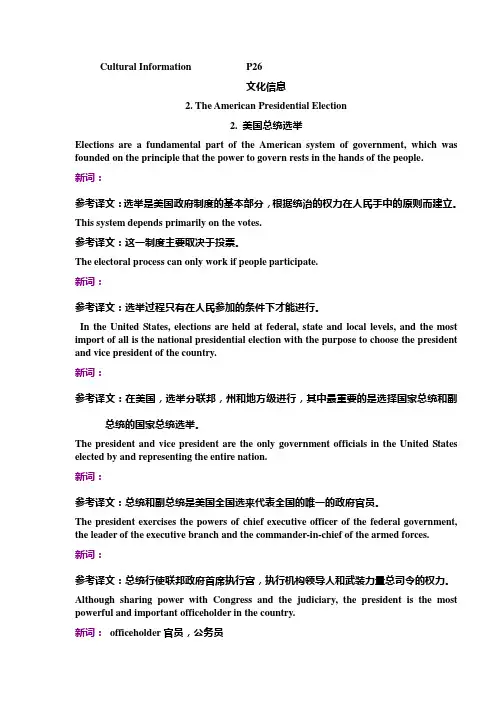
Cultural Information P26文化信息2. The American Presidential Election2. 美国总统选举Elections are a fundamental part of the American system of government, which was founded on the principle that the power to govern rests in the hands of the people.新词:参考译文:选举是美国政府制度的基本部分,根据统治的权力在人民手中的原则而建立。
This system depends primarily on the votes.参考译文:这一制度主要取决于投票。
The electoral process can only work if people participate.新词:参考译文:选举过程只有在人民参加的条件下才能进行。
In the United States, elections are held at federal, state and local levels, and the most import of all is the national presidential election with the purpose to choose the president and vice president of the country.新词:参考译文:在美国,选举分联邦,州和地方级进行,其中最重要的是选择国家总统和副总统的国家总统选举。
The president and vice president are the only government officials in the United States elected by and representing the entire nation.新词:参考译文:总统和副总统是美国全国选来代表全国的唯一的政府官员。
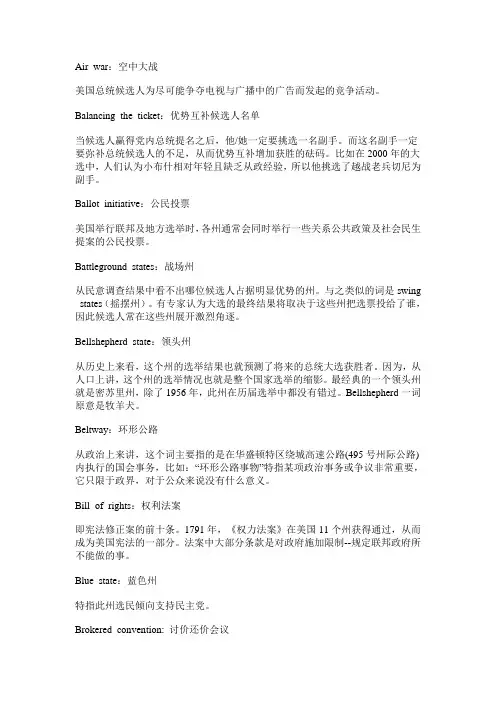
Air war:空中大战美国总统候选人为尽可能争夺电视与广播中的广告而发起的竞争活动。
Balancing the ticket:优势互补候选人名单当候选人赢得党内总统提名之后,他/她一定要挑选一名副手。
而这名副手一定要弥补总统候选人的不足,从而优势互补增加获胜的砝码。
比如在2000年的大选中,人们认为小布什相对年轻且缺乏从政经验,所以他挑选了越战老兵切尼为副手。
Ballot initiative:公民投票美国举行联邦及地方选举时,各州通常会同时举行一些关系公共政策及社会民生提案的公民投票。
Battleground states:战场州从民意调查结果中看不出哪位候选人占据明显优势的州。
与之类似的词是swing states(摇摆州)。
有专家认为大选的最终结果将取决于这些州把选票投给了谁,因此候选人常在这些州展开激烈角逐。
Bellshepherd state:领头州从历史上来看,这个州的选举结果也就预测了将来的总统大选获胜者。
因为,从人口上讲,这个州的选举情况也就是整个国家选举的缩影。
最经典的一个领头州就是密苏里州,除了1956年,此州在历届选举中都没有错过。
Bellshepherd一词原意是牧羊犬。
Beltway:环形公路从政治上来讲,这个词主要指的是在华盛顿特区绕城高速公路(495号州际公路)内执行的国会事务,比如:“环形公路事物”特指某项政治事务或争议非常重要,它只限于政界,对于公众来说没有什么意义。
Bill of rights:权利法案即宪法修正案的前十条。
1791年,《权力法案》在美国11个州获得通过,从而成为美国宪法的一部分。
法案中大部分条款是对政府施加限制--规定联邦政府所不能做的事。
Blue state:蓝色州特指此州选民倾向支持民主党。
Brokered convention: 讨价还价会议在初选或者党代表大会的第一轮投票中,旨在获得该党提名的候选人未获得大多数选票时,这次会议就被称之为“讨价还价会议”。
美国大选的一些词汇1.red states/blue states(红州/蓝州)共和党支持率较高的州在大选地图上用红色标示,蓝色则代表民主党2.Two Americas(两个美国)民主党候选人克里在大选中,指责现任总统布什的经济政策导致美国社会出现严重分化。
克里说他眼里有两个美国:一个富人的美国和一个穷人的美国。
3.Incivility(粗野)毫无疑问,这个单词也与美国大选有直接联系,它是许多美国电视评论员在评价两位总统候选人的三场电视辩论时最常挂在嘴边的一个词。
4.预选会议(Caucus)特指以促进政治上或组织上的变化为目的的聚会。
在美国选举政治中,这个词专指在提名总统候选人的过程中,党的地方活动人士举行的会议。
所谓"分层"预选会议制,是指政党地方活动人士在地方选区会议上选出参加高一级行政区会议的代表,这一级代表再选出参加州一级会议的代表,最后由州级会议代表选出参加本党全国提名代表大会的代表。
预选会议制旨在通过选出支持某一候选人的代表来表明政党在各州内的党员所希望推举的本党总统候选人。
这种做法使决定总统候选人的程序始于基层,因此将总统提名程序民主化。
5.燕尾提举力(Coattails)从旧时绅士长礼服后下摆"燕尾"一词引申而来,在美国政治中,指一位在职民选官员或竞选公职的候选人利用自己的声望给本党其他候选人增加胜选机会的能力──好似让别人受其燕尾之提举,顺势走向胜利。
6.会后弹升(Convention bounce)在共和党或民主党全国代表大会完成总统候选人提名的几天内出现的这位候选人在民意调查中声望上升的现象。
7.辩论(Debate)近年在美国政治中,往往指由电视现场传播的总统或副总统候选人间的辩论;他们通过回答媒体或观众的提问来阐述自己和自己政党的立场观点。
8. 分掌政府(Divided government)通常指白宫由一个政党控制(即总统是这个党的成员),而国会参、众两院中的至少一院由对立派政党控制(即其成员占多数)的局面。
竞选总统胜选退出政坛…英文怎么说?「政治」英文用语汇整!美国总统大选即将来临,现任美国总统欧巴马也即将退任,但全世界目前的关注焦点并不是欧巴马的八年政绩,而是有大砲之称的川普会不会选上美国总统。
川普之所以具有高关注性,就是因为他时常迸出的不当言论,透露出他对种族与性别等议题的偏见。
到底川普都说了些什么东西?到底新闻都是怎么讲这些政治新闻的?因此英文老师 Benjamin 在 Engvid 上介绍了各式各样常见的政治用词,让读者可以更清楚地理解这些政治人物究竟都发表了什么言论。
01. to enter politics 加入政坛这个用法多使用现在式与过去式,鲜少使用未来是,若要表达此人未来将加入政坛,则会改使用动词 get into。
e.g He entered politics when he was 17.(他在十七岁时就加入了政坛。
)02. to hold a general election 举办普选这个用法多使用未来式或过去式,也可以用被动式。
03. to stand for the Presidency 竞选总统04. to launch a campaign 举办竞选活动05. to win an election 赢得选举06. to serve (number) years as… 担任…为期(时间)e.g He served five years as a trivia quiz host in London.(他在伦敦担任了五年机智问答节目的主持人。
)07. to cut the crime rate 降低犯罪率08. to leave politics (to pursue…) 退出政坛(去做…)09. an economic boom 经济繁荣10. a proud achievement 最成功的政策加入政坛英文, 胜选英文, 川普, 政治, 政治用语, 政治英文, 政治英文用语, 竞选活动英文, 竞选总统英文, 经济繁荣英文, 举办普选英文, 英文单字, 词组, 退出政坛英文, 降低犯罪率英文。
TopicOutlineAbstractBody partReference1就职演说中的高频词汇奥巴马的就职演说中高出其他总统平均词频的特有高频词排在第一的是“一代”(Generation, 7次) , 也是唯一列入前十高频词中的特有词, 位于十位以后的特有词还有“危机”(Crisis) 、“艰难”(Hard) 、“工作” (Job) 、“忍耐” ( Endure) 等都出现了4次。
早在就职典礼前, 奥巴马的助手即披露演说主题为“责任与义务”。
奥巴马在演说中提到, 政府和“每个美国人”都面临一个“需要责任感的新时代”。
对政府而言, 奥巴马认为保障就业是责任感体现之一。
奥巴马说: “我们今天要问的不是政府是否太大或太小, 而是它是否起作用———能否帮助家庭找到提供体面薪酬、医疗保健和退休金的工作”。
奥巴马强调: “如果答案是肯定,我们将继续前行。
如果答案是否定, 任何计划都将无果而终。
”对民众而言, 奥巴马强调在这个“能够定义一代人的时刻”, 共渡难关需要每个人发扬“服务精神”, 贡献自己的力量。
“工作”。
“工作” (work) 这个词近30年来用得相对较多, 用得最多的是奥巴马( 8次) 。
奥巴马的就职背景非常特殊, 面对美国最严重的经济危机, 大批公司倒闭, 失业人数大增。
奥巴马很清楚这必须要经历艰苦的工作。
为了给人们面对困难的信心, 他在历史中找到了艰苦奋斗的传统, 他提到正是有了美国的开创者们“历尽艰辛, 全力奉献,不辞劳苦, 直至双手结起层层老茧”才有了美国今日的成就。
而现在“无论我们把目光投向何处,都需要靠我们的工作”, 所以他号召所有美国人“重新开启再造美国的工作”。
2009年:高频词:国家美国人民工作一代世界共同时代寻求精神奥巴马用了15次“国家”, 他在演说中首先回顾美国的光荣历史,以唤起其民族自豪感和责任, 然后强调“美国仍是一个年轻的国家”, “无论美国政府能做多少,必须做多少, 美国国家的立国之本最终还是美国人的决心和信念”, 最后表示要为国家尽责, 应对危机。
Key words of American election (美国选举核心词汇)核心会议Caucus特指旨在决定政治上或组织上改变的会议。
在美国总统竞选政治中,本词指各党地方组织在总统提名期间召开的骨干党员会议。
“层次分明的”骨干党员会议体制指党的区一级骨干分子选举出席县一级会议的代表;县级会议则选举州级会议代表;州级会议选举出席该党全国总统提名大会的代表。
骨干党员会议体制旨在通过代表的遴选显示该党各州党员究竟倾向谁为总统候选人,其实效是使总统提名民主化,因为候选人的挑选基本上决定于区一级,即整个进程的最初阶段。
保守派Conservative 指从温和的中右派到坚定右派之间不同色彩的各种政治观点。
就美国两大政党而言,共和党一般被认为偏于保守。
在美国,一般来说,“政治上”的保守派主张自由市场经济原则以及低税收;就政府权力分配来说,偏重州政府和地方政府分权,而反对联邦政府集权。
“文化上”的保守派则反对堕胎或无节制的大众媒体的宣传。
辩论Debate 就一个问题的两个或两个以上矛盾面所进行的辩论。
在美国政治中,近年来辩论与电视节目挂钩,即总统或副总统候选人在电视上亮相,阐述其本人及该党的观点,回答媒体或观众提出的问题。
辩论可以通过广播,也可以在社区群众大会上进行。
各级政府公职人员的选举均可进行辩论。
分治的政府Divided government一般指总统属于一个政党,而国会的参众两院至少有一院由反对党控制的政治局面。
此种情况也可能发生在州一级,即州长属于一个党,而另一党控制州议会。
在美国政府制度中,常出现两党分治。
其历史影响则是减少急剧改革,促使两党政治家在立法提案上进行妥协。
联邦竞选法Federal Election Campaign Act(FECA) 这项1971年制定的法律规定了联邦选举的财务事项,曾于1974、1976及1979三度修订。
该法要求候选人及政治委员会公开资金来源及开支情况,同时规定联邦大选期间接受捐款及开支款项事宜。
2016总统大选英文热词►Air war:空中大战美国总统候选人为争夺电视与广播中的宣传而发起的竞争活动。
近年来,网络广告(online adverts)开始占据更重要的地位。
►Balancing the ticket:优势互补的候选人名单总统候选人会选择一名能弥补其不足的副总统候选人,从而增加获胜砝码。
比如在2008年大选中,相对年轻的奥巴马,挑选了经验丰富的拜登为副手。
►Ballot initiative:公民表决提案美国部分州允许公民提出立法措施或修订州宪法。
如果某个提案获得足够多签名,该州就可以对提案进行投票。
如投票通过,就成为法律。
►Battleground states:战场州很难从民意调查中看出哪个党的候选人占据明显优势的州。
与之类似的词是swing states (摇摆州),候选人常在这些州展开激烈角逐。
战场州通常包括这几个州:佛罗里达州(Florida)、俄亥俄州(Ohio)、宾夕法尼亚州(Pennsylvania)。
►Bellwether state:领头州领头州的选举结果通常能预测总统大选获胜者。
因为,从人口上讲,这个州的选举情况也就是整个国家选举的缩影。
最经典的一个领头州就是俄亥俄州,从1960年以来,此州在历届选举中都没有错过。
Bellwether一词来源于系铃的公羊,是羊群的头领。
►Beltway:环形公路这个词喻指华盛顿特区绕城高速公路内执行的国会事务。
“Beltway issue”(环形公路问题)就是政界或媒体觉得很重要,但对于公众来说没有什么意义的问题。
“Beltway mentality”(环形公路思维)就是与大众脱节的思考方式。
►Blue state:蓝色州特指此州选民倾向支持民主党(Democratic Party)。
►Caucus:预选会议指在提名总统候选人的初期,党的地方活动人士举行的会议,目的是选出本党的党代表。
►Coattails:燕尾提举力指一位在职民选官员或竞选公职的候选人利用自己的声望给本党其他候选人增加胜选机会的能力——好似让别人受其燕尾之提举,顺势走向胜利。
►Convention bounce:会后弹升在共和党或民主党全国代表大会完成总统候选人提名的几天内,候选人在民意调查中声望上升的现象。
►Constitution of the United States:美利坚合众国宪法通称美国联邦宪法或美国宪法。
它是美国的根本大法,奠定了美国政治制度的法律基础。
美国宪法是世界上第一部成文宪法。
1787年5月,美国各州(当时为13个)代表在费城召开制宪会议,同年9月15日制宪会议通过《美利坚合众国宪法》。
1789年3月4日,该宪法正式生效。
后又附加了26条宪法修正案。
►Commander in chief:最高统帅美国宪法赋予总统的作为全军统帅的角色。
►Donkey, Democratic:驴,民主党在美国,“驴”是民主党的象征。
►Elephant, Republican:象,共和党“象”是共和党的象征。
►Front-runner:领先者在竞选或提名过程中被认为呼声最高或最有希望当选的候选人。
►Filibuster:(为拖延新发通过)发表冗长演说根据美国参议院的议事规则,在就一项法案或动议进行投票表决前,参议员们要就相关法案内容进行辩论或发表意见,而议员们发言时,时间上没有限制。
参议院利用这种程序发表冗长演说,阻止议案通过的行为就是“filibuster”。
►Grand Old Party (GOP):大老党共和党是美国当前的两个主要政党之一,别称“大老党”。
►Grassroots campaign:基层竞选在竞选过程中,候选人往往都会下基层拉选票,这叫“基层竞选”,也可以称之为“草根竞选”。
在这种场合中,候选人会跟普通民众拉家常,介绍自己的施政纲领,询问选民的诉求,跟支持者合影等等。
►Hanging / Pregnant chad 悬挂式/怀孕式孔屑孔屑是打孔机打穿下来的纸屑。
投票时,投票人在自己要选的候选人名字旁边的孔印处打孔,孔印被击穿,孔屑随即脱离选票,选举即算完成。
孔芯在2000年总统选举中成为焦点。
由于佛州的投票结果两党票数非常接近,有必要检查选票重新统计。
因为有些选民在打孔后,孔屑未与选票分离(即悬挂式孔屑)。
而有些选民的选票上有打孔痕迹,但是没有被打穿(所以就像孕妇怀着宝宝一样,怀孕式孔屑)。
►Hard money:硬钱个人直接向某个竞选活动捐出的钱。
►Home stretch:冲刺阶段选举活动接近尾声,进入冲刺阶段。
这个短语原意为赛马比赛时的终点直道。
进入冲刺阶段后,候选人更是马不停蹄地四处奔走,为争取选民的支持做最后的努力。
►Landslide victory:压倒性胜利指在竞选活动中获得绝对多数选票。
例如1988年老布什以426张选举人票当选总统。
他的民主党对手只得到111张选举人票。
►Independent:独立选民那些宣布自己不属某个特定党派的选民都可以称为独立派人士。
由于多数注册为某党派的选民通常会投某党派候选人的票,大选竞选的重点是赢得独立选民的支持。
在全国范围内有近三分之一的选民认为自己是独立派人士,不过,在一些关键州,独立选民的比例比其它一些州更大一些。
►Mudslinging:揭发隐私对政敌的诬陷和中伤。
这个词原意是往别人身上扔泥,在竞选中指对敌对政党的恶意中伤。
比如说给对方抹黑的竞选宣传,有些甚至是故意误导的攻击性宣传。
►McCain-Feingold:麦凯恩-法因戈尔德法案以两位主要发起人麦凯恩参议员和法因戈尔德参议员命名的竞选资金改革法案。
制订这一法案的目的是限制地下筹款活动和联邦竞选开支。
这一法案禁止了“软钱”,对使候选人受益的议题广告进行了限制。
►National convention:全国党代表大会全国党代表大会每隔四年举行一次,来自全国各州的党代表参加会议投票选出该党的总统和副总统候选人。
全国党代表大会目前主要起到使大多数选民在各州党内初选表达的意愿正式化的作用。
通常,获得最多党代表票的人将会接受该党的总统提名。
现在的党代表大会也是总统候选人介绍副手和起草政策主张的平台。
►Neck and neck:支持率不分上下两位候选人支持率难分高下。
这个短语来自赛马比赛,指两匹马齐头并进,很难分清楚哪一匹在前面,也可以解释为并驾齐驱。
现在常用于比赛及竞选活动,指竞争者支持率不分上下,很难预测谁会取胜。
►Plurality rule:简单多数原则指选举中按多数票决定胜出的办法。
多数票即某一候选人所获选票数大于任何其他对手,但往往不是总票数的一半。
例如一候选人得票30%,另一人也得票30%,而第三人得票40%,第三人便获得了多数票,从而竞选胜利。
►Public funding:公共资助指由美国财政部拔款给总统竞选活动作为其部分资金。
此款全部来自所得税,美国纳税人在交付联邦所得税时可自愿指定一部分作为竞选捐助。
►Platform:政纲在美国总统选举政治中,指政党表达其原则和目标的正式书面声明,起草于总统候选人提名程序的尾声。
近年来,由于电视越来越注重候选人的个性及其显现给人们的领导才能,政纲的重要性逐渐消失。
►Political Action Committee (PAC):政治行动委员会一个为了宣传其成员对特定议题观点而组建的组织,通常进行筹集款项的活动,随后资助支持这一组织立场的候选人。
政治行动委员会对候选人的投票记录进行监督,就有关成员感兴趣的议题询问候选人的看法,将收集到的信息交给赞助者。
由于联邦法律对个人、公司或工会向候选人提供的资金额进行了限制,政治行动委员会成为向政治进程提供大笔资金和影响选举的重要渠道。
►Primary election:预选选举遴选参加某一公职竞选的政党候选人的选举。
政府各级的选举都可以有预选,包括地方上的市长选举,选区内的国会众议员选举,全州范围的州长或国会参议员选举,以及总统大选。
在"不公开的"("closed ")预选选举中,只有本党的注册党员可以投票。
在"公开的"("open")预选选举中,作为合格选民的一个政党的人可以参加另一个政党的预选投票(这些人被称为"cross-over" voters,即"跨党"投票人)。
总统预选选举在州一级举行,选出各州选民心目中的政党总统候选人。
按照各州自己的法律,有些州的选民直接投票推选他们属意的候选人,有些州的选民则把票投给"保证"在党的提名代表大会上支持某一候选人的代表。
那些安排在竞选进程早期举行的州预选,有时会带来始料未及的结果,使原来呼声甚高的竞选人失去势头,而本来知名度不那么高的竞选人实力激增。
预选选举是与"预选会议"不同的一种预选方式。
►Protest vote:逆反票明知没有得胜希望、但仍然投给第三党或某个小党的票,目的是表达对两个主要政党的候选人的不满。
►Push polling:导向性民意调查民意测验中使用的一种技巧:向选民提出关于某争论事项或关于某候选人的非常具体的问题,用以测出竞选中可能出现的话题。
某些不择手段的竞选运动工作者会使用此种技巧,在问题中参杂错误信息或误导信息,即将选民“推离”其竞选对手。
►Purple state:紫色州摇摆州的又一说法,可能投票给民主党(蓝色)或者共和党(红色)的州。
►Reagan Democrat:里根民主党人指1980年和1984年总统选举中的一些民主党选民,他们没有投票给民主党总统候选人,却投给了共和党总统候选人里根,因为他们更支持里根的社会和金融政策。
这个词目前也指温和派民主人党人,他们比其他民主党人在国家安全或者移民议题上持更为保守的立场。
►Red state:红色州选民倾向于投票给共和党(Republican Party)的州。
►Running Mate:竞选伙伴总统候选人选择的一个政治同事一同参加总统选举。
如果当选的话,竞选伙伴将成为副总统。
►Regionalization:区域化全美50个州形成非正式的六个区域。
在总统预选过程中,区域化是指一个区域内的几个州把预选都安排在同一天举行,从而可以最大程度地发挥本地区对选举进程的影响。
►Single-member district:单一席位选区这是美国现行的联邦和州议员的产生办法,即每个选区有一个议员名额,竞选中获简单多数票的候选人当选。
单一席位选区制意味着,在一个选区只能有一个政党获胜。
与此相对的是比例代表制(proportional system)。
比例代表制的选区范围相对大得多,每个选区有数名议员代表,并且是在同一次选举中按各政党的得票比例产生。